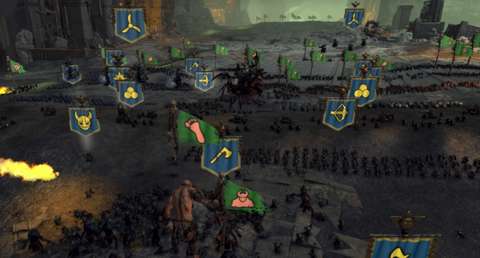Can the Total War Formula Succeed Outside of a Real-World Setting?
Fantasy tactics.
Creative Assembly has built a franchise around human history. Shogun: Total War depicted battles on the fields of feudal Japan. Rome: Total War showed the titular republic's transformation into an empire. And Total War: Attila showed that same empire crumble under internal turmoil and foreign invasion, forever changing the face of the world.
But with its next real-time strategy game, Total War: Warhammer, Creative Assembly is abandoning the familiar annals of human civilization for tales of goblins, dwarfs, and fire-breathing dragons.
"We have much more creative freedom this time around," designer Richard Aldridge told me during a recent hands-on demo with Total War: Warhammer. "We're not confined by reality, or history, or human machinery. We can throw giant spiders onto the battlefield, cast magical spells, and really have fun with the Total War formula."
I was skeptical of this direction at first. To me, the historical aspects of Total War were always the most fascinating. Watching actual empires rise and fall by my hand, conquering provinces I could point to on a map, defeating Napoleon, the Huns, the Hattori Clan--for me, victories always felt more visceral when reflecting historical events.
Sclash - Console Release Date Trailer Kingdom Come: Deliverance 2 - Official Cinematic Announcement Trailer Stellar Blade - BIBI ‘Eve’ Official Music Video Trailer | PS5 Apex Legends: Urban Assault Collection Event Trailer Total War: WARHAMMER III - Elspeth von Draken Gameplay Showcase Genshin Impact - "Arlecchino: Sleep in Peace" | Official Character Teaser Potionomics: Masterwork Edition - Official Announcement Trailer Snowbreak: Containment Zone - "Gradient of Souls" Version Trailer Harold Halibut GameSpot Video Review Nancy Drew: Mystery of the Seven Keys | World Premiere Official Trailer Modern Warfare III & Warzone - Official Cheech & Chong Bundle Gameplay Trailer SteamWorld Heist II – Official Reveal Gameplay Trailer
Please enter your date of birth to view this video
By clicking 'enter', you agree to GameSpot's
Terms of Use and Privacy Policy
But then a kamikaze-goblin with wooden wings launched into my right flank, while a giant spider collapsed on my left. I commanded my Dwarven army on a rectangular patch of dirt far beneath the surface,and all around me, the enemy emerged from ancient tunnels. My hands-on demo, unlike my prior experiences with Total War, was not of this world. And it's encouraging that it still felt like the fine-tuned strategy Creative Assembly is known for.
"Working with Warhammer as an existing franchise is, in many ways, the same as working with historical events," Aldridge said as I turned my cannons to impede a battalion of advancing goblins. "We're looking at different creatures and thinking 'What can we do with this?' And amazing things come out of the team's brainstorming."
The battle before me broke into two separate skirmishes, bisected by several giants that ascended from the depths behind me. On Aldridge's advice, I diverted my Dwarven Slayer squad to the scene. These units excel when fighting beasts--of whatever size--and after 30 seconds of sustained attacks, the Slayers proved worthy of their name.
There's also a level of detail here that was absent in previous Total War installments. With the tap of a key, my camera zoomed into an over-the-shoulder view of my selected unit, the hero unit, High King Thorgrim. The perspective was chaotic, to say the least--the camera bounced and shook to the tempo of the monarch's mobile throne--but it provided a cinematic view I wasn't used to. For once, I was among the soldiers, a far cry from the omniscient general's bird's eye view.

"We're trying to provide something that feels real," Aldridge told me, laughing at the irony in that statement. "Even though it's our first game set in a fantasy world, we also want it to be our most authentic."
And despite the novelty of this world, it still sparked feelings reminiscent of my time in Creative Assembly's feudal Japan, or on Medieval fiefdoms. The first battle I commanded, with Aldridge watching over my shoulder, was on the normal difficulty. Although I defeated my opponents, it wasn't without its cost. A Dwarven commander even lamented the price my army paid: "Yes, we have victory. But with such losses, can we really call it that?"
My second battle, on the Hard difficulty, was a different story altogether. I survived the first few waves of Goblin enemies. But when the giants lumbered into the fray this time, my adversary's AI attacked my Slayers from the other side. Without them to lean on during bestial attacks, the giants advanced through my lines at a leisurely pace. Even my airborne gyrocopters couldn't take the monstrosities down.

"Warhammer will take practice, just like earlier games," Aldridge said as the "Defeat" status filled my screen. "You'll have to learn the intricacies of each unit, and figure out how to put them to use in the best way. There's magic involved, and fantastical heroes, and Dwarven tunnels. But it's still an RTS game."
When Total War: Warhammer releases next year, it will feature four factions: the aforementioned Dwarfs and Greenskin Goblins, as well as the human Empire and the Vampire Counts. All of them will have unique units and abilities, some fueled by magic, others by impractical machinery. None of them are part of our human history. But my hands-on demo diminished my skepticism. Total War: Warhammer may not continue the tradition Creative Assembly has always relied on, but after playing it for a short time, I'm excited to see how this decision plays out.
Got a news tip or want to contact us directly? Email news@gamespot.com
Join the conversation